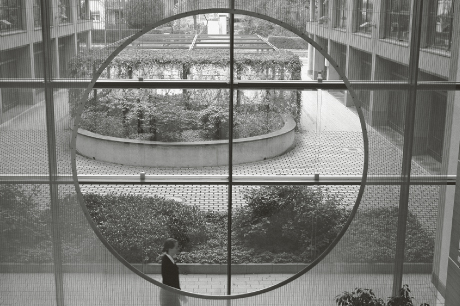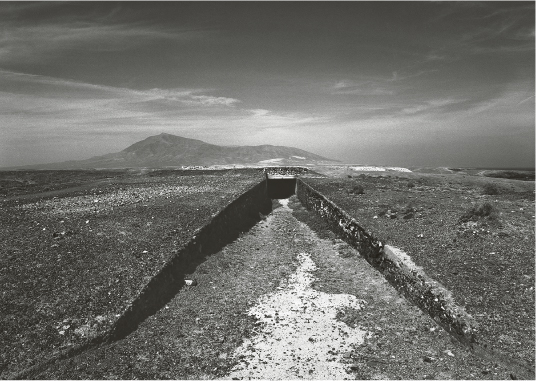24 How to Deal with the Center of an Image
Most beginners place the center of interest of their photos in the middle without giving it much thought. When is center placement a good idea and when is it not?
Camera technique—especially with easy, self-focusing cameras, which adjust sharpness in the center—makes it easy for you to place subjects in the center of the image. Most of the resulting photos, however, lack sufficient tension. Therefore, it is an especially good idea for beginners to consciously force themselves to place the subject off center and to structure their image so that it is focused on two main points of interest (the next chapter will show you how to do it).
However, under certain exceptional circumstances, it might be a good idea to put the center of attention in the middle, and it also makes sense to sometimes compose symmetrically. The Russian filmmaker Andrei Tarkowski, for example, always stressed the power of symmetry and therefore of center-weighted pictorial composition to achieve an archaic, sacred effect in the image. His films Nostalgia and Solaris are emphatic examples of the force that this kind of composition has.
Another option for center placement is to use a vanishing perspective, which achieves a pictorial effect by pulling the viewer into the image as if by suction—thus creating movement in the picture to make it interesting and to prevent boredom. Circular composition is another kind of composition that uses center-based design.
Vanishing Perspective in the Tunnel
The extreme vanishing perspective pulls your focus into the dark vanishing point located in the center of the landscape (figure 24–1). However, what lies beyond this dark point? Is it a tunnel? What function does the tunnel have? The image leaves these questions unanswered and therefore has a surreal effect. Your eyes are inescapably attracted to the tunnel entrance by the two vanishing lines located along the central perspective. The black spot, to which your gaze always inevitably falls, unfolds a somewhat haunting magic. After all, the barren landscape with scanty vegetation does not look cozy in the first place, and the path leading to the tunnel makes it look rather eerie. With this subject, a center-based composition makes sense in spite of the fact that the black spot is located a bit to the right, something the eye does not notice at first.
The photo was taken with the 35 mm wide-angle lens of an analog Mamiya 645 (which corresponds to a 21 mm lens in small format) and the negative was scanned and processed with Photoshop. The medium-tone contrast was increased by about 30%.
This next photo (figure 24–2) has also been composed virtually around the center, but after looking at it more carefully, you notice that the vanishing point is located a little to the right and especially above the middle. You already know that the eye loves dissimilar sizes even if they almost look identical, as is the case here and in the previous image. And yet, the total impression here is of a composition that stresses the center, which once again makes sense because your eye is pulled into the depths by the center-based perspective. All four oblique lines in the image lead the eye to the vanishing point.
Additional compositional strength is found in the repeated light and shadowed squares on each side of the image, which taper off toward the vanishing point. Naturally, this photo is full of symbols and it conveys a bit of a Hitchcock-like atmosphere. The lack of perfect focus does not diminish pictorial impact.
The photo was taken with the 35 mm lens of a small analog viewfinder camera at full aperture at ![]() s without a tripod during a backpacking tour.
s without a tripod during a backpacking tour.


Child and Buddha
Contrary to the two other photos, the one in figure 24–3 is composed in a completely asymmetric way. The most important element in it, the girl’s face, is in the lower-left section of the image, and the counterweight, the Buddha’s eyes, are in the upper-right section. The child, who is seen here blowing a bubble with her gum, is linked to the sublime eyes of the Buddha in a way that is open to many interpretations: perhaps profane versus sacred or the innocence and freedom of a child versus the innocence and freedom of the Buddha.
I especially recommend such pictorial compositions to amateurs: Place the essential element on the edge of the photo and then search for a counter-weight and incorporate it into the image. This creates tension, as you will see in the next chapter.
The photo was taken with an analog camera without a tripod, using a 105 mm telephoto and shot at ![]() s. Due to the mediocre lighting conditions, I had to shoot at full aperture, and therefore, the depth of field is minimal. Obviously, it made sense to focus on the child even if it blurred most of the image.
s. Due to the mediocre lighting conditions, I had to shoot at full aperture, and therefore, the depth of field is minimal. Obviously, it made sense to focus on the child even if it blurred most of the image.
New York Street Scene
In the photo in figure 24–4, your eye is disappointed at first because the center is mostly empty, filled only by surface lines created by the skyscraper’s structure. A person stands before this sterile wall, and a rapidly moving, slightly blurred person wearing a cap walks by in front of the camera. An essential element in this picture is the view of the background seen in the right edge because it creates pictorial tension and spatial depth. If you cover this edge, the photo becomes flat and loses tension. This proves that even the edge of a photo can be essential for pictorial composition: Although not much occurs in the center, the narrow edge teems with structures and activity. Piet Mondrian often composed his abstract canvases with centers filled only by large, white surfaces and edges filled with small surfaces painted with the three primary colors.

I must remind you that this photo—a typical, every-day scene in an urban setting, in which three people just walk by each other without engaging in any mutual contact—would have looked boring without the two people in the foreground. Their surroundings are sterile and almost capable of crushing and converting them to small, scurrying little wheels amid the urban hustle and bustle.
This photo was taken with an analog camera using a 28 mm lens. I composed the elements by placing the centers of attention in the right and lower edge of the image rather than in the center.
Circular Composition
The circle, a compositional element of calmness, symbolizes unity in the visual arts and architecture. Interestingly, the builder of this uniquely designed, modern building in Bad Homburg near Frankfurt did not place the brace exactly through the middle of the circle, and therefore, this element of the centrally composed photo (figure 24–5) is not its exact axis of symmetry either. As I have mentioned, the eye loves dissimilar sizes that cannot be immediately comprehended. Here, the circle provides a framework for perspective and leads your gaze to the inner patio of the building; the woman walking by makes the photo come alive. After all, this is a structure built for people, and it was especially important to show the relationship between humans and their spatial surroundings. The photo was taken digitally using a standard lens.

However, a circular composition does not have to be dominated by a circular shape; an ellipse also has the same impact of unity. In the next photo (figure 24–6), several cars have left their circular tracks in the foreground as the drivers turned them around. The small cemetery chapel in the background has a layer of dark slate, and this dark chapel is precisely what intensifies the photo’s surreal effect, whereas the circle in the foreground represents unity and harmony. Here, it would have been inappropriate to attempt to create tension through an asymmetrical composition, but a symmetrical pictorial composition, supported by a circle, intensifies the archaic or—as is the case here—sacred impression of this image.

This photo was taken with an analog camera with a 28 mm wide-angle lens.


